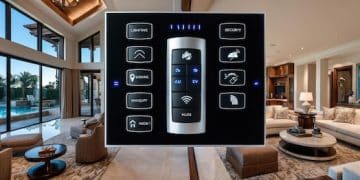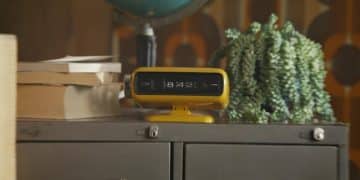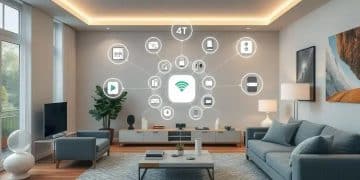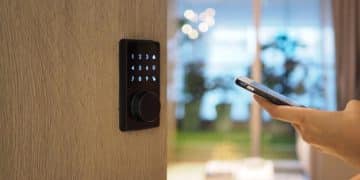How to Integrate Matter Devices into Your Smart Home in 2025
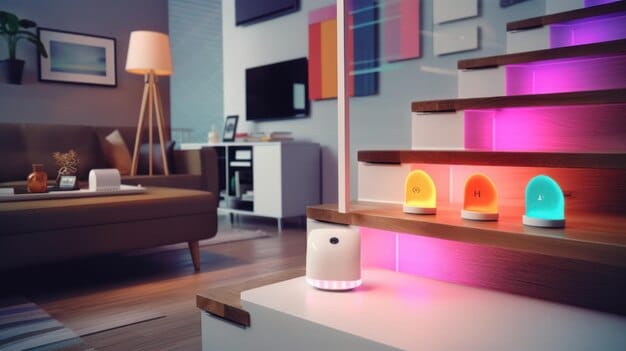
Integrating Matter-enabled devices into your existing smart home in 2025 involves ensuring compatibility, updating your smart home hub, adding new devices, creating routines, and keeping your devices updated for optimal performance and security.
Ready to make your smart home even smarter? With Matter, the new connectivity standard, integrating devices is about to get a whole lot easier. Here’s your guide on how to integrate Matter-enabled devices into your existing smart home in 2025.
Understanding Matter and Its Benefits
Matter is a revolutionary connectivity standard designed to unify smart home devices. It aims to make devices from different manufacturers work together seamlessly, enhancing user experience and simplifying smart home management.
One of the primary benefits of Matter is its interoperability. No longer will you need to worry about whether a device is compatible with your existing ecosystem. If it’s Matter-enabled, it should work.
Key Advantages of Matter
Embracing Matter in your smart home has several notable benefits.
- Interoperability: Devices from different brands work together seamlessly.
- Simplified Setup: Easier pairing and setup processes.
- Enhanced Security: Robust security protocols to protect your smart home network.
- Improved Reliability: Local control ensures devices work even when the internet is down.
Matter also promises enhanced security. It incorporates robust encryption and authentication protocols, protecting your smart home from potential cyber threats. This is especially crucial as more devices connect to our networks.
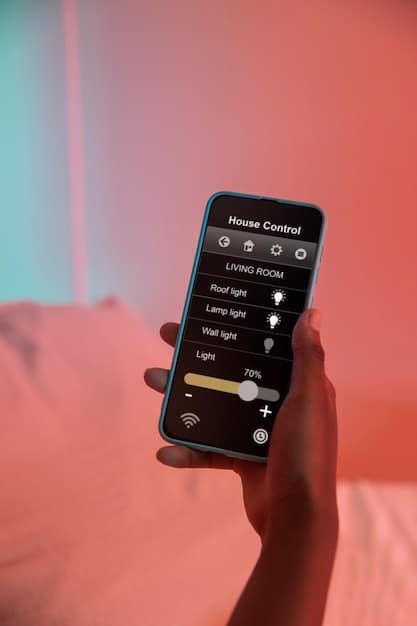
The reliability of Matter-enabled devices is another significant advantage. Many Matter devices support local control, meaning they can communicate directly with each other without relying on a cloud connection. This ensures that your smart home continues to function even if your internet goes down.
In summary, understanding Matter and its benefits is the first step towards creating a more unified, secure, and reliable smart home in 2025.
Assessing Your Existing Smart Home Infrastructure
Before integrating Matter devices, it’s crucial to assess your current smart home setup. This involves identifying your existing devices, understanding your current hub or ecosystem, and ensuring compatibility with Matter.
Start by listing all your smart home devices. Note the brands, models, and connectivity protocols they use (e.g., Zigbee, Z-Wave, Wi-Fi). This inventory will help you determine which devices are compatible with Matter and which may need to be replaced or upgraded.
Next, examine your smart home hub or ecosystem. Popular hubs include Amazon Echo, Google Nest, Apple HomePod, and Samsung SmartThings. Check if your hub supports Matter and what updates may be required to enable this support.
Hub Compatibility
Ensuring your hub is Matter-compatible is essential for seamless integration.
- Check Manufacturer’s Website: Visit the official website of your hub manufacturer to verify Matter support.
- Software Updates: Ensure your hub has the latest firmware to enable Matter functionality.
- Compatibility List: Review the list of Matter-compatible devices supported by your hub.
It’s also important to check if your existing devices can be upgraded to support Matter via firmware updates. Some manufacturers may offer updates that allow older devices to work with Matter.
Assessing your existing smart home infrastructure is a critical step in preparing for the integration of Matter-enabled devices. It ensures a smooth transition and helps you avoid compatibility issues.
Updating Your Smart Home Hub for Matter Support
To fully leverage Matter, updating your smart home hub is necessary. This ensures that your hub can communicate effectively with Matter-enabled devices, streamlining the setup and management process.
The first step is to check for firmware updates. Most smart home hubs have an automatic update feature, but it’s a good idea to manually check for updates to ensure you have the latest version.
If your hub doesn’t support automatic updates, visit the manufacturer’s website for instructions on how to perform a manual update. This usually involves downloading the latest firmware and installing it via a USB connection or a dedicated app.
Steps to Update Your Hub
Follow these steps to update your smart home hub for Matter support.
- Check for Updates: Access your hub’s settings through its app or web interface.
- Download Firmware: If an update is available, download the latest firmware.
- Install Update: Follow the on-screen instructions to install the update.
- Restart Hub: Once the update is complete, restart your hub.
After updating your hub, you may need to configure additional settings to enable Matter support. This usually involves linking your hub to your Matter network and granting it permission to communicate with Matter-enabled devices.
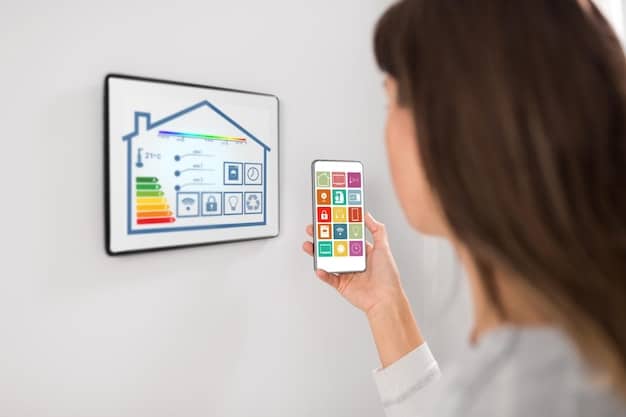
Updating your smart home hub is a straightforward process that can significantly enhance your smart home experience. It ensures compatibility with Matter devices and unlocks new features and capabilities.
Adding New Matter-Enabled Devices to Your Network
Once your hub is updated, you can begin adding new Matter-enabled devices to your network. This process is designed to be simple and intuitive, making it easy to expand your smart home ecosystem.
Start by ensuring that the device is in pairing mode. This usually involves pressing a button on the device or using its accompanying app to initiate the pairing process.
Next, use your smart home hub’s app to scan for new devices. The app should detect the Matter-enabled device and prompt you to add it to your network.
Follow the on-screen instructions to complete the pairing process. This may involve entering a pairing code or scanning a QR code on the device.
Tips for Adding Devices
Here are some tips to ensure a smooth device setup.
- Proximity: Keep the device close to your hub during the pairing process.
- Stable Wi-Fi: Ensure a stable Wi-Fi connection for seamless integration.
- Read Instructions: Refer to the manufacturer’s instructions for specific pairing guidance.
After the device is paired, you can configure its settings and add it to your smart home routines. This allows you to control the device using voice commands or automate its functions based on pre-set conditions.
Adding new Matter-enabled devices is a seamless process that enhances the versatility and functionality of your smart home.
Creating Smart Home Routines with Matter Devices
One of the most exciting aspects of integrating Matter-enabled devices is the ability to create sophisticated smart home routines. These routines allow you to automate various functions based on specific triggers, enhancing convenience and efficiency.
Start by defining the desired outcome of your routine. For example, you might want to create a “Good Morning” routine that turns on the lights, adjusts the thermostat, and starts playing your favorite music.
Next, identify the devices that will be involved in the routine. This could include smart lights, smart thermostats, smart speakers, and other Matter-enabled devices.
Use your smart home hub’s app to create the routine. Most apps offer a user-friendly interface for defining triggers and actions. You can set the routine to trigger based on time, location, or sensor input.
Example Routine
Consider this example of a routine you can create.
Routine Name: “Movie Night”
Trigger: Voice command (“Alexa, start movie night”)
Actions:
- Dim the lights
- Turn on the TV
- Adjust the thermostat
- Close the smart blinds
Creating smart home routines with Matter-enabled devices can significantly improve your quality of life. It allows you to automate mundane tasks and create a personalized smart home experience.
Troubleshooting Common Matter Integration Issues
While Matter is designed to be seamless, you may encounter issues during the integration process. Troubleshooting these issues effectively can save time and frustration.
One common issue is device discovery. If your hub is not detecting a Matter-enabled device, ensure that the device is in pairing mode and within range of the hub.
Another issue is connectivity. If a device is disconnecting frequently, check your Wi-Fi signal strength and ensure that the device is not too far from your router.
Compatibility issues may also arise. Ensure that your hub and devices are running the latest firmware and that they are certified to work with Matter.
Troubleshooting Tips
Here are some tips to help resolve common Matter integration issues.
- Restart Devices: Reboot both your hub and the affected device.
- Check Firmware: Ensure all devices have the latest firmware updates.
- Proximity: Keep devices close to the hub during setup and operation.
- Network Stability: Verify your Wi-Fi network is stable and strong.
If you continue to experience issues, consult the manufacturer’s support resources. Many manufacturers offer online documentation, FAQs, and customer support channels to assist with troubleshooting.
By addressing common issues with a systematic approach, you can effectively troubleshoot Matter integration problems and enjoy a seamless smart home experience.
Future Trends in Matter-Enabled Smart Homes
As Matter continues to evolve, several exciting trends are emerging in the smart home landscape. These trends promise to further enhance the functionality, convenience, and security of Matter-enabled smart homes.
One trend is the proliferation of Matter-certified devices. As more manufacturers embrace Matter, the availability of compatible devices will increase, giving consumers more choices and flexibility.
Another trend is the integration of Matter with new smart home technologies, such as AI and machine learning. This will enable smart homes to become more intelligent and adaptive, learning user preferences and automating tasks proactively.
Enhanced security features are also on the horizon. Future Matter devices will incorporate advanced encryption and authentication protocols, protecting smart homes from increasingly sophisticated cyber threats.
Emerging Trends
Here are some emerging trends to watch for in the future of Matter-enabled smart homes.
- Energy Management: Smarter energy usage and reduced costs.
- Healthcare Integration: Improved health monitoring and assistance.
- Home Security: Advanced security features and threat detection.
- Customization: Greater personalization and user control.
The future of Matter-enabled smart homes is bright. These homes promise to be more seamless, secure, and intelligent, enriching our lives in countless ways.
| Key Point | Brief Description |
|---|---|
| 💡 Understanding Matter | Matter is a new standard for smart home device interoperability. |
| ⚙️ Hub Update | Update your smart home hub to support Matter devices. |
| ➕ Adding Devices | Pair Matter devices through your updated hub. |
| 🏠 Creating Routines | Automate your smart home with custom routines. |
Frequently Asked Questions
▼
Matter is a unified connectivity standard ensuring smart devices from different brands work together seamlessly. It’s important because it simplifies smart home management and enhances user experience by promoting interoperability and security.
▼
Check the manufacturer’s website for your smart home hub. They will have information on whether your hub supports Matter. Also, ensure your hub has the latest firmware installed for Matter functionality.
▼
Matter-enabled devices offer enhanced interoperability, simplified setup, improved security, and increased reliability. They promote seamless integration across different brands and ensure your smart home functions even without an internet connection.
▼
Some manufacturers may offer firmware updates that allow older devices to support Matter. Check with the device manufacturer to see if an update is available for your specific model to enable Matter compatibility.
▼
First, ensure all your devices and hubs have the latest firmware updates. Restart your devices and check your Wi-Fi connection. If problems persist, consult the manufacturer’s support resources for troubleshooting assistance and guidance.
Conclusion
Integrating Matter-enabled devices into your existing smart home in 2025 can greatly enhance its functionality and convenience. By understanding Matter, assessing your current infrastructure, updating your hub, adding new devices, creating routines, and troubleshooting issues, you can enjoy a seamless and intelligent smart home experience.
